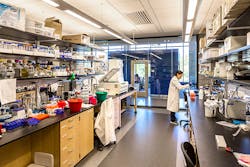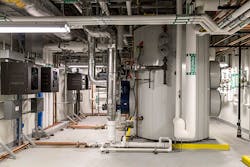Latest from Green
Sponsored
Georgia Tech’s Engineered Biosystems Building features sustainable systems
The facility, which is targeting USGBC LEED Platinum, is an innovative model of interdisciplinary health sciences research and education, which includes several communal areas aimed at fostering collaboration among researchers in the fields of chemical biology, cell therapies and systems biology. The building, which also includes wet laboratories, laboratory support spaces and offices, allows Georgia Tech to consolidate its biomedical research efforts in the prevention, diagnosis and treatment of cancer, diabetes, heart disease, infections and other life-threatening conditions.
The EBB contains “research neighborhoods” designed around a specific focus or topic. These neighborhoods bring together scientists, engineers and researchers from different disciplines around common themes or areas of interest. They share laboratories, offices and common spaces.
Stairs alternate on various floors, encouraging people to move within the neighborhoods and throughout the building and interact with one another. Small and informal meeting areas are located near the stairwells, to further encourage researchers to talk with one another.
McCarthy Building Companies Inc. took a phased approach in the mobilization of the construction work in that construction began midway through the preconstruction phase of the project. This allowed McCarthy to provide constructability feedback early on in the process to ensure Georgia Tech’s high standards were met.
“Laboratories are commonly known as energy guzzlers due to the intense mechanical and electrical demands,” explained Ben Watkins, vice president of Operations, Southeast Division, McCarthy Building Companies, Inc., project director of the EBB. Georgia Tech, the design teams — which included the engineering firm of Newcomb & Boyd and mechanical contractor Mann Mechanical, and McCarthy — were all focused on making this facility as sustainable as possible.
Sustainability chillin’
Located in the labs and research spaces, one impressive sustainability feature of the building is 365 Trox active chilled beams. Chilled beams act as air induction and diffusion devices that introduce conditioned air to control temperature and/or humidity and deliver primary air through a series of nozzles using water.
Conditioned primary air is ducted to active beams. This primary air must satisfy the ventilation and latent requirements of the space and drive the induction of room air through the beam’s coil.
There was originally some hesitation about this addition due to the humid Atlanta climate; however, a side-by-side experiment with forced air was conducted on campus and proved the beams would significantly minimize energy for heating and cooling.
Water, the main transporter of thermal energy, permits very high-energy carrying capacity via pipes — a big advantage over larger, far less efficient, forced air conveyance. A forced air system is, by its very nature, greatly less efficient because of the inherently low density of air and requires large ducts to transport BTUs. Newcomb & Boyd had used chilled beams on a smaller scale at several other facilities at Georgia Tech, and according to energy modeling reviews, it was determined that the chilled beams were an efficient HVAC method.
In addition, floor-to-floor building height can be reduced and space can be maximized because chilled ceilings/chilled beams don't need large ductwork and fans.
Because Georgia Tech has a very dedicated measurement and verification system onsite, it was determined that “the chilled beam system, which was completed in March of this year, performed well over the summer months. The low energy consumption and maintenance-free operation makes it a great choice,” said Watkins.
The top floor mechanical “penthouse” houses the primary Johnson Control York air handling units and ductwork runs. Miura boilers provide process heating for the sterilization of lab equipment.
Water collection
Water collected on the site via condensate, rainwater and ground water removal is stored in two building cisterns that have a combined capacity of 24,200 gallons and connect with another 77,000-gal. capacity adjacent cistern. Water is recycled for a graywater flushing system and irrigation.
The EBB is located on a spring and drainage tributary within the campus Eco-Commons — another significant factor in the building’s design. The building has a permanent foundation drainage system to accommodate the groundwater present at such a deep elevation.
“The foundation drainage system is a network of gravity drained perforated pipes underneath the slab on grade of the building,” said Watkins. “Groundwater is collected into a large sump pit in the basement level of the building and then pumped out to a cistern on the building exterior. There the water is stored, along with rainwater and condensate water from HVAC processes, until it is recycled into the facility for toilet flushing.”
The building's foundation was fitted with a system to permanently extract the groundwater, alleviating the hydrostatic pressure on the slab on grade level of the basement, which is nearly 40 feet deep in some places on the sloping site. The team designed a conduit to a low collection point, and pumps that water to the filtration and cistern system.
Other sustainable features
Leveraging sufficient daylight to minimize the need for artificial lighting while not adding to the building’s heating load, was a major factor in several aspects of the design including:
• More than 12,100-sq.ft. of vertical perforated zinc panels, shade glass panels and windows on the exterior surfaces receiving the most direct sunlight.
• A three-level system of light shelves use 50-ft. X 4-ft. sections of three-layer laminated glass to reflect light deep into the interior.
• Metal horizontal lattice elements extend horizontally from the rooftop PV arrays to provide shade.





